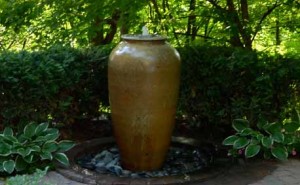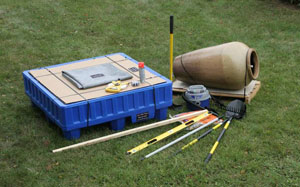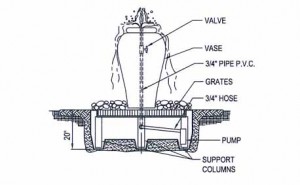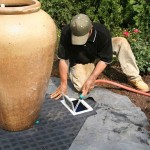Water Feature for your Home Garden
 April 18, 2012
April 18, 2012
When you think of water, what are the initial words you use to illustrate it? Most of us would say peaceful or relaxing. The gentle sounds of flowing water and its soothing sight is such a pleasure to everyone. Adding one or more fountains to your garden, whether outdoor or indoor, gives a more relaxing feel to your space and adds beauty. There are a number of people who are interested in building their own garden water feature. One possible choice is a Vase style fountain.
A vase is an open container, often used to hold cut flowers. It can be made from a number of materials including ceramics and glass. The vase is often used as a fountain and thus used to extend the beauty of its contents.
Having a vase fountain in your Minnesota garden, or any garden for that matter, is not all that hard. These vase fountains can do the trick by adding a spark to your garden’s ambience and setting the mood of your desire. Each has its own uniqueness, showing a different perspective and can express your personality.
Vase Fountain Types – Open Pool and Reservoir
You can install a vase style fountain using two very different approaches. You can either install your vase fountain in an open pool of water. This could be a natural pond, even with koi, or an open fountain pool. Another style is a reservoir style fountain. This type of fountain is hard work, but fairly easy to construct.
How to install an in ground Reservoir Style Vase Fountain
Below are step by step instructions for installing a Vase style fountain using a 52.5†square aqua box that is 20†high. This size reservoir holds 130 gallons of water which helps keep your water clean and clear. If you are interested in purchasing a fountain kit, or having us install one for you, contact us, Niwa Design Studio, at 952-470-1882.
Fountain Installation Guidelines using a 52.5†x 52.5†x 20†H fountain box
- Select and clear the area for your fountain, 6’x6’ or a little more.
- Excavate a hole that is 5’ x 5’ and 22†deep..
- Add 1†of sand or gravel and level the bottom of the hole.
- Set the fountain reservoir into the hole and verify that it is level. The rim of the box should be approximately 1†below the ground of the surrounding area. If you installing your fountain in patio, deck or other hard surfaced area you will need to spend time and be very accurate when installing the fountain box. The transition from a hardscape area to a fountain like this is very important. You will also need to consider the drainage pattern of your hardscapes making sure that runoff does not flow into the reservoir, this would create sediment build up and make it more difficult to keep your fountain water clean.
- Back fill the space between the fountain box and your hole. You can use the end of a 2×4 board to pack the soil as you add it. In addition you can run water into the space to help the soil settle into the air pockets that exist. You may want to add some weight on top of the box while back filling to ensure that the reservoir does not rise up during this step.
- Clean the inside of the box removing any debris, chunks of soil and/or rocks.
- Now that the fountain box, or fountain reservoir has been installed you can remove the top cover and install the fountain feature. In this case we are using a Vase.  Note that we have also used this fountain box for stone and copper features as well.
- With this example we are using a Vase with a ¾†pace pipe with a valve to adjust the flow inside already installed. With this pre-plumbed Vase on its side and the piping extending out the bottom pull a short section of a ¾†hose that is connected to your pump from the fountain box and connect to the bottom of the ¾†pace. You are now ready to slowly raise the fountain into an upright vertical position with its base centered on the top of the fountain cover. Be sure to not kink the hose while performing this step.
- Double check that the fountain feature is level and standing properly on the grate. The fountain feature should always be standing even and stable.
- Double check that the hose is firmly connected to your fountain pump and if so start filling your fountain box, or reservoir, and a portion of your vase with clean tap water. Once the basin is filled you are ready to test your fountain. Keep in mind that a fully filled fountain box and vase will overflow once the power is turned off, this is why you may want to test your fountain before completely filling the vase.
- You can use the valve installed in the plumbing of your water feature to adjust the flow of the water. You can also consider installing a light inside the vase if this effect is something you may be interested in. Another way to illuminate your fountain is with up lighting , a down light from a nearby structure or tree.
- Once you have adjusted the flow of your vase style water feature to your liking, you can add a decorative rock over the cover of the fountain box. We use black polished pebbles, natural polished pebbles in assorted colors and beach pebbles with a permeable landscape fabric covering the edge of the box and the ground.
Cleaning your Vase Fountain:
You should protect your investment and take good care of your vase fountain. Do this by keeping your fountain free from leaves and other debris. Debris that accumulates around the fountain blocks the water from flowing back into the basin and can case your pump to burn out. Also the accumulation of decomposing organic matter in the water changes the color of the water to brownish color. If this happens in your fountain you can add chlorine tablet to water to remove the discoloration.
Filling the Water:
The fountain box we have been talking about is called an Aquabox and can hold a large volume of water which means you can run your fountain for longer periods of time without refilling. Water depletion occurs to evaporation and splash. During extends periods of time without rain the water level in your fountain will drop due to these effects, you can simply refill your fountain using a simple garden hose. We have installed auto fills on many of our fountain projects by connecting a simple toilet float to an irrigation mainline. These work great inside an Aquabox and are easily hidden. Another advantage to a larger reservoir is that you can leave town without needing to worry about wrecking your fountain pump by running it without water.
Freezing Climatic Conditions:
Do not run your water fountains during freezing temperatures. During the periods of light freezing temperatures, you can run the fountain as long as the flow keeps the fountain warm. But during the extreme cold conditions, it is advised to turn off the fountain and drain the water out of the vase. Once this done cover the top of the vase keeping with a heavy plastic or piece of tarp keeping any water from collecting inside.  A vase with too much water in it through the winter can be a problem. Expanding and contracting water from freezing and thawing can easily crack any vase.
Keep in mind that there are a number of fountain features that can be placed on top of the Aquabox. We have used this Aquabox for vases and stone fountain features and have been very happy with the outcome.
I hope you have found this article helpful. Please feel to take a look at our product list on our “about us” page of our official site for garden fountain features on sale and feel to contact us if you would like our help with your water feature project.
You can also visit Japanese Garden Journal for more information about Japanese Gardens.




 Posted in
Posted in  content rss
content rss